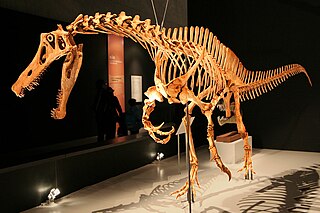
Irritator is a genus of spinosaurid dinosaur that lived in what is now Brazil during the Albian stage of the Early Cretaceous Period, about 113 to 110 million years ago. It is known from a nearly complete skull found in the Romualdo Formation of the Araripe Basin. Fossil dealers had acquired this skull and sold it to the State Museum of Natural History Stuttgart. In 1996, the specimen became the holotype of the type species Irritator challengeri. The genus name comes from the word "irritation", reflecting the feelings of paleontologists who found the skull had been heavily damaged and altered by the collectors. The species name is a homage to the fictional character Professor Challenger from Arthur Conan Doyle's novels.

Placoderms are vertebrate animals of the class Placodermi, an extinct group of prehistoric fish known from Paleozoic fossils during the Silurian and the Devonian periods. While their endoskeletons are mainly cartilaginous, their head and thorax were covered by articulated armoured plates, and the rest of the body was scaled or naked depending on the species.

Cladoselache is an extinct genus of shark-like chondrichthyan from the Late Devonian (Famennian) of North America. It was similar in body shape to modern lamnid sharks, but was not closely related to lamnids or to any other modern (selachian) shark. As an early chondrichthyan, it had yet to evolve traits of modern sharks such as accelerated tooth replacement, a loose jaw suspension, enameloid teeth, and possibly claspers.

Heintzichthys is an extinct monospecific genus of arthrodire placoderm that lived what is now Europe and North America during the Famennian stage of the Late Devonian period. The type specimen was discovered in the Cleveland Shale near Cleveland, Ohio, in the United States.
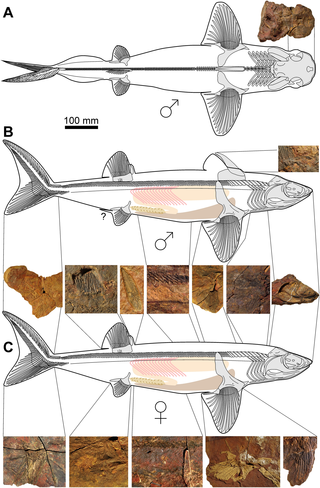
Cladoselachidae is an extinct family of cartilaginous fishes closely related to, and possibly nested within, Symmoriiformes. They are characterized by having an elongated body with a spine in each of the two dorsal fins. In 2023, a paper describing a new cladoselachian, Maghriboselache found that it, and Cladoselache, were the only members of the family, greatly limiting the temporal range for this group to the Late Devonian.

Hybodontiformes, commonly called hybodonts, are an extinct group of shark-like cartilaginous fish (chondrichthyans) which existed from the late Devonian to the Late Cretaceous. Hybodonts share a close common ancestry with modern sharks and rays (Neoselachii) as part of the clade Euselachii. They are distinguished from other chondrichthyans by their distinctive fin spines and cephalic spines present on the heads of males. An ecologically diverse group, they were abundant in marine and freshwater environments during the late Paleozoic and early Mesozoic, but were rare in open marine environments by the end of the Jurassic, having been largely replaced by modern sharks, though they were still common in freshwater and marginal marine habitats. They survived until the end of the Cretaceous, before going extinct.

The Eugeneodontida, sometimes also called Eugeneodontiformes, is an extinct and poorly known order of cartilaginous fishes. They possessed "tooth-whorls" on the symphysis of either the lower or both jaws and pectoral fins supported by long radials. They probably lacked pelvic fins and anal fins. The palatoquadrate was either fused to the skull or reduced. Now determined to be within the Holocephali, their closest living relatives are chimaeras. The eugeneodonts are named after paleontologist Eugene S. Richardson, Jr. The group first appeared in the fossil record during the late Mississippian (Serpukhovian). The youngest eugeneodonts are known from the Early Triassic. The geologically youngest fossils of the group are known from the Sulphur Mountain Formation, Vardebukta Formation and Wordie Creek Formation (Greenland).

Gorgonichthys is extinct monospecific genus of large arthrodire placoderm. Fossils are found in the Upper Famennian Cleveland Shales of Late Devonian in Ohio. The type species is Gorgonichthys clarki.
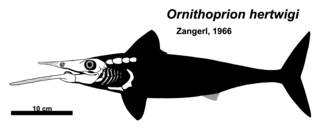
Ornithoprion is a genus of extinct cartilaginous fish in the family Caseodontidae. The only species, O. hertwigi, lived during the Moscovian stage of the Pennsylvanian, between 315.2 to 307 million years ago, and is known from black shale deposits in what is now the Midwestern United States. The discovery and description of Ornithoprion, performed primarily via radiography, helped clarify the skull anatomy of eugeneodonts; a group which includes O. hertwigi and which were previously known primarily from isolated teeth. The genus name, which is derived from the ancient Greek órnith- meaning 'bird' and príōn meaning 'saw', was inspired by the animal's vaguely bird-like skull and the saw-like appearance of the lower teeth. The species name honors Oscar Hertwig.
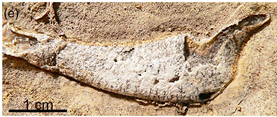
Gogoselachus is an extinct genus of cartilaginous fish known from the late Devonian of Australia. It is one of the earliest well-preserved Devonian chondrichthyans, as much more of the fish than just teeth and scales were preserved. This rare preservation reveals some unique discoveries about the evolution of the cartilage that was inside later cartilaginous fish such as sharks, rays, and chimaeras.
Ozarcus is an extinct genus of symmoriiform cartilaginous fish from the Carboniferous period of Arkansas. The type species, Ozarcus mapesae, was named in 2014 based on cartilaginous skulls from the Serpukhovian-age Fayetteville Formation. The genus is named after the Ozark Mountains while the species was named after its discoverer, G. K. Mapes.

Iberodactylus is a genus of pterodactyloid pterosaurs belonging to the clade Anhangueria, that during the Early Cretaceous lived in the area of present Spain. The type species is Iberodactylus andreui.
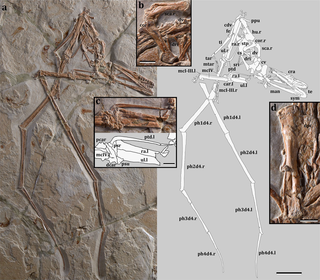
Mimodactylus is a genus of istiodactyliform pterosaur that lived in what is now Lebanon during the Late Cretaceous, 95 million years ago. The only known specimen was discovered in a limestone quarry near the town of Hjoula, belonging to the Sannine Formation. The owner of the quarry allowed the specimen to be prepared and scientifically described by an international team of researchers. When it was eventually sold, the buyer donated it to the MIM Museum in Beirut. In 2019, the researchers named the new genus and species Mimodactylus libanensis; the generic name refers to the MIM Museum, combined with the Greek word daktylos for "digit", and the specific name refers to Lebanon. The well-preserved holotype specimen is the first complete pterosaur from the Afro-Arabian continent, and the third pterosaur fossil known from Lebanon.

Dracopristis is an extinct genus of ctenacanth that lived during the Carboniferous period in North America, around 307 million years ago. The species was discovered in the Kinney Brick Quarry in New Mexico, US. Like many fossils from the site, the fossils of Dracopristis are very well-preserved. A single species is known, Dracopristis hoffmanorum, which is named in honor of Ralph and Jeanette Hoffman, the owners of the quarry. Prior to being scientific named, D. hoffmanorum was informally referred to as the "Godzilla shark".

Romerodus is an extinct genus of cartilaginous fish in the family Caseodontidae. While it and the rest of its family were historically considered elasmobranchs related to sharks and rays, they are now regarded as holocephalans, a diverse subclass which is today only represented by chimaeras. Romerodus is known from the Carboniferous and possibly Permian periods of North America, and the only named species, R. orodontus, was discovered in organic shale deposits in the U.S. state of Nebraska. It is one of few members of its order, the Eugeneodontida, that is known from multiple complete, well preserved body fossils, and is thus an important taxon for understanding the anatomy and ecology of less well preserved eugeneodonts such as Helicoprion. The genus name honors paleontologist Alfred Romer.
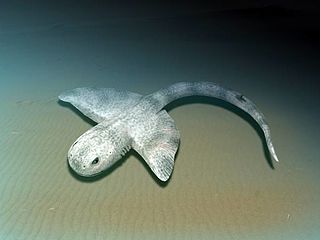
Squatinactis is a genus of extinct elasmobranch chondrichthyan known from the Carboniferous aged Bear Gulch Limestone in Montana. This fish was discovered in 1974 by Richard Lund. The type specimen, named CMNH 46133, consists of a brain case, poorly preserved jaws and gills, a pectoral fin, and a partial vertebral axis. This creatures most startling feature were its broad pectoral fins which resembled those of stingrays and angel sharks (Squatina). The holotype specimen has about 15 teeth in its jaw. This creature is named after the angel shark. Remains found in the South Urals of Russia and the Eyam Limestone of Derbyshire, England, have been tentatively identified as those belonging to S. caudispinatus.

Phoebodontiformes is an extinct group of elasmobranchs, known from the Devonian and Carboniferous periods. It includes the genera Phoebodus, Diademodus and Thrinacodus. Phoebodus and Thrinacodus have slender, elongate bodies. Their teeth are tricuspate. Some studies have recovered the group as paraphyletic.

Amazichthys is an extinct genus of selenosteid arthrodire from the Middle Famennian of the Late Devonian of the Anti-Atlas Mountains of Morocco. It contains a single species, Amazichthys trinajsticae. It is one of a few example of placoderm known from whole body shape, including cartilaginous axial and fin elements.

Ferromirum is an extinct genus of symmoriiform cartilaginous fish known from the late Devonian Ibâouane Formation in the southeastern Anti-Atlas of Morocco, with a single species Ferromirum oukherbouchi. It is known from a single well preserved skeleton, which is of a small individual less than half a metre in length. The jaws and hyoid arch are preserved uncrushed. The skull has large orbits which have sclerotic rings. The teeth are small and have a cladodont morphology. The body is slender. The first dorsal fin has a smooth fin spine, which curves posteriorly towards its tip.
Cosmoselachus is an extinct genus of symmoriiform chondrichthyan from the Upper Carboniferous aged Fayetteville Shale of Arkansas, United States. The genus contains a single species, C. mehlingi, which is known from a partial specimen that includes the cranium, jaws, gill arches, pectoral fins, and teeth.


























